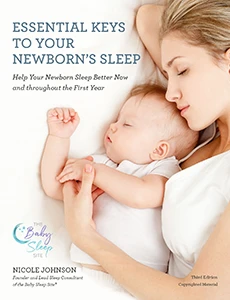
There are lots of questions about using a humidifier in a baby’s bedroom. Which kind of humidifier is best? Cool mist, warm mist, a vaporizer? Then, of course, there’s the all-important question of if parents should even have a humidifier in their baby’s bedroom at all. Lots of parents are using them and they make great gifts for new parents, but do they really belong there? What are the benefits? Are there any risks?
Comfortable Babies Sleep Better
It’s a common belief that having a humidifier in the bedroom is only necessary when a baby has a cold. They remember how their own parents would use a vaporizer to relieve their congestion and cold when they were young. The fact is that a humidifier can help a baby to sleep better all the time, not just when they are sick.
The air inside your home can become dry during the winter, uncomfortably so. The air outside of your home is less humid and the heat from your heating system saps moisture from the air inside the home.
This creates a lack of moisture that leaves you feeling uncomfortable. It makes your skin itchy and can cause dry patches. You might notice your lips become chapped easier too. Not to mention dry nasal passages that lead to congestion and a stuffy nose, and possibly even nose bleeds.
These discomforts make it much more difficult to get to sleep at night, and that’s as an adult. So you know you can do something to help relieve the situation. Imagine what it must be like for a baby or infant to sleep at night when they don’t understand what is happening, why it’s happening, and have no way to do anything about it.
Dry air can also be cooler. Have you ever found yourself thinking that the heat of summer wouldn’t be all that bad if it wasn’t so humid? Well, the reverse is true for winter. You’d feel warmer – and better – if there was some extra humidity in your home. As an adult, you could grab an extra sweater and warm up a little. For babies though, the only thing they can do is cry and hope you can tell what they want.
An added benefit of using humidifiers for babies could be the white noise they generate. There has been some evidence that this quiet, ambient white noise can help little ones to sleep better. Pediatricians believe that children actually sleep better when the room isn’t completely quiet. Babies can hear noises in the womb, and they can be amplified to over twice as loud as a vacuum cleaner. As such, babies can feel more comfortable in a nursery where there’s some noise going on.
If your baby gets fussy or congested a lot but doesn’t show any symptoms of illness, you should consider using a humidifier. Now that that’s out of the way, it’s on to the obvious next question.
What Type of Humidifier is Best for a Baby’s Nursery?
-
Cold Mist Humidifiers
A cool mist humidifier works by pressurizing water, breaking it down into tiny particles, and then forcing it back out into the air. As the water doesn’t get heated, there is some concern that these humidifiers just rotate germs back into the nursery air. However, there are plenty of options when it comes to choosing a cold mist humidifier. Some humidifiers will use ultrasonic sounds to break apart water particles, while others use chemicals. As with any kind of humidifier, the key is to always keep it clean and follow the manufacturer’s instructions.
-
Warm Mist Humidifiers
A warm mist humidifier – or a vaporizer – converts water into steam by heating it before dispersing it throughout a room. As the process does involve heat, viruses and germs are eliminated during this process. However, make sure that the unit is kept out of the reach of children for safety’s sake. A warm mist humidifier can cost more than a cold mist one, and it will take a little electricity to use.
Filter or Non-Filter
Most modern humidifiers on the market have filters that ensure the water vapor released by the machine is as clean and germ-free as possible. Filters should be changed regularly anywhere between twice a week or once a month, depending on how often the humidifier is used. This can add a significant cost to owning a humidifier. Some humidifiers come with removable filters that can be taken out, washed, and reused. These come with a higher up-front cost but can save money in the long run.
Best-Use Suggestions
When it comes to humidifiers for babies, pediatricians recommend using one with a built-in humidistat. That will allow you to track the humidity levels for the nursery. The ideal humidity level is 50%.
Whether using a cool-mist or warm-mist humidifier in the room, it’s important to always follow the manufacturer’s instructions about the type of water you should use and whether it’s safe to add things like essential oils.to your humidifier. It’s also vital to follow the instructions for cleaning the humidifier. Lots of parents who use humidifiers in the winter report they get the best results when they take time to clean it each day, which should only take about three or four minutes.








